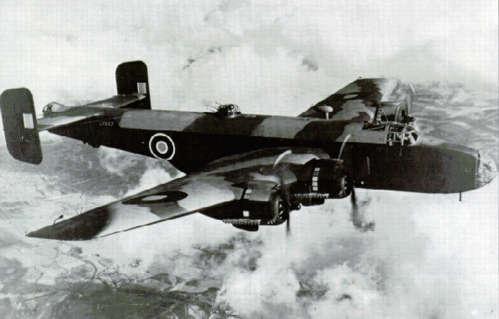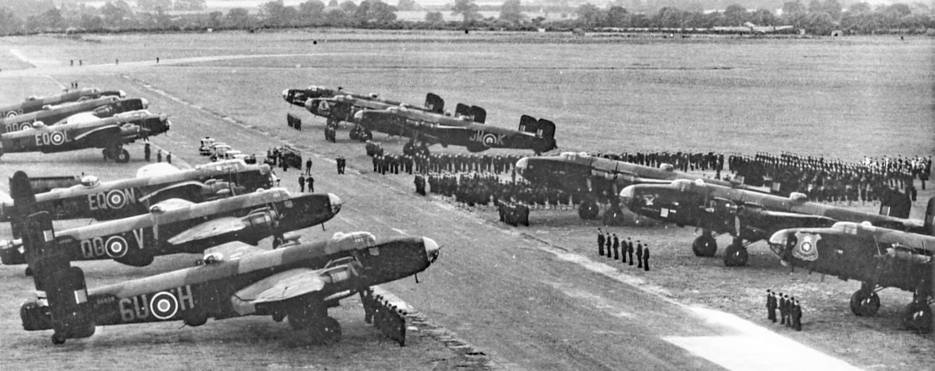 Bomber Command
Bomber Command  |
Aircrew Chronicles
|
Aircrew Losses
|
Nose Art
|
BCATP
|
Lancaster
|
Media
|
Aircrew Chronicles
|
Aircrew Losses
|
Nose Art
|
BCATP
|
Lancaster
|
Media
 Bomber Command
Bomber Command  |
Aircrew Chronicles
|
Aircrew Losses
|
Nose Art
|
BCATP
|
Lancaster
|
Media
|
Aircrew Chronicles
|
Aircrew Losses
|
Nose Art
|
BCATP
|
Lancaster
|
Media

|
The Halifax was the second of the four-engined heavy bombers to enter service with the Royal Air Force. The huge Stirling was already operational, but the prototype Lancaster had yet to fly in November 1940, when No. 35 squadron began operations with what became affectionately known as the "Halibag."
|
Designer George Volkert's design featured a 103 foot wingspan and was powered by four Rolls Royce Merlin engines, the same used by the Hawker Hurricane and Supermarine Spitfire. The first Halifax flew in October 1939.
However, all was not well with the design of the Halifax. A significant design modification was made after some inexplicable losses of fully loaded aircraft had shown that it was possible for the Halifax to enter an inverted and uncontrollable spin. A second major problem was a lack of engine power. In fact, most of the problems resulted from the Merlin engine, or more specifically, how they were installed. The propellers of the Halifax were placed too close to the leading edge of the wings. This disturbed the airflow over the wing, causing poor performance of the aircraft, compared to the Lancaster. Despite these problem, the Halifax was a sturdy and reliable aircraft and was generally well liked by its crews.
The problems were resolved with the Halifax Mk III which was powered by Bristol Hercules engines. These were placed correctly in relation to the wings, but most of all, were much more powerful than the Merlin engines. Although the Halifax's performance now matched the Lancaster's, Bomber Command's head Arthur Harris retained a preference for the Lancaster.

This was a blessing in disguise for other Commands. Unlike the Lancaster, the Halifax was released for other duties. At the peak of its service with Bomber Command some thirty-four squadrons operated the aircraft in Europe and four more in the Middle East. The Halifax was also operated by nine squadrons of the RAF's Coastal Command for anti-submarine, meteorological, and shipping patrols. RAF Transport Command used the aircraft as casualty, freight, and personnel transports. As well, two 'special duty' squadrons which had the task of dropping special agents and supplies into enemy territory flew Halifaxes. |

|
And yet, its main task remained bombing Germany. Of the total Halifax production of 6,178 aircraft, 4,751 were bombers. Between 1941-45, the Halifax completed some 75,000 sorties (compared with the Lancaster's 156,000) with Bomber Command alone, dropping close to a quarter of million tons of bombs. Each Halifax could carry a maximum of 14,500 lb (6,600 kg) of various ordnance. As its bomb bay was divided into six compartments, the biggest individual bomb it could withhold was 2,000 lb (910 kg). The Lancaster had one large unobstructed bomb bay, enabling it to carry a single 12,000 lb bomb.
However, the Halifax had one important advantage over the Lancaster. In an emergency, the roomier Halifax was easier to abandon which resulted in a superior survival ratio of Halifax crews compared to those in Lancasters.
All of the heavy bomber squadrons of the Royal Canadian Air Force were equipped with the Halifax for at least part of the war. The squadrons suffered grievous losses flying the Merlin-powered Mk II's, but later models that incorporated an improved vertical stabilizer design and Bristol Hercules 14 cylinder radial engines made for a more powerful and stable aircraft and it became well respected amongst Canadian aircrew. As Lancaster production increased, in particular the of the Lancaster Mk X's being manufactured in Canada, many of the Canadian squadrons were converted to Lancasters.
3675 RCAF airmen lost their lives flying in Halifaxes, more than any other aircraft type in Bomber Command. 3349 were lost in Lancasters and 2586 in Wellingtons.
Sadly, not a single example of the aircraft was placed in a museum following the war. However, in 1996 a Canadian group (Halifax57 Rescue) successfully raised Halifax NA-337 from 750 feet below the surface of Lake Mjosa in Norway. It has been restored and is on display at the RCAF Memorial Museum at Trenton, Ontario. Our museum is working with Halifax57 Rescue to recover an RCAF Halifax from the Baltic Sea off of Sweden, parts of which will be used to build a Halifax for the Bomber Command Museum of Canada.

|
Engines: Wingspan: Length: Height: Loaded Weight: Empty Weight: Maximum speed: |
four Rolls Royce V-12's or Bristol Hercules radials 104 feet, 2 inches (31.72m) 71 feet, 7 inches (21.81m) 20 feet, 9 inches (6.32m) 68 000 pounds (30845kg) 39 000 pounds (17690kg) 312 miles per hour (502 km/h) |
